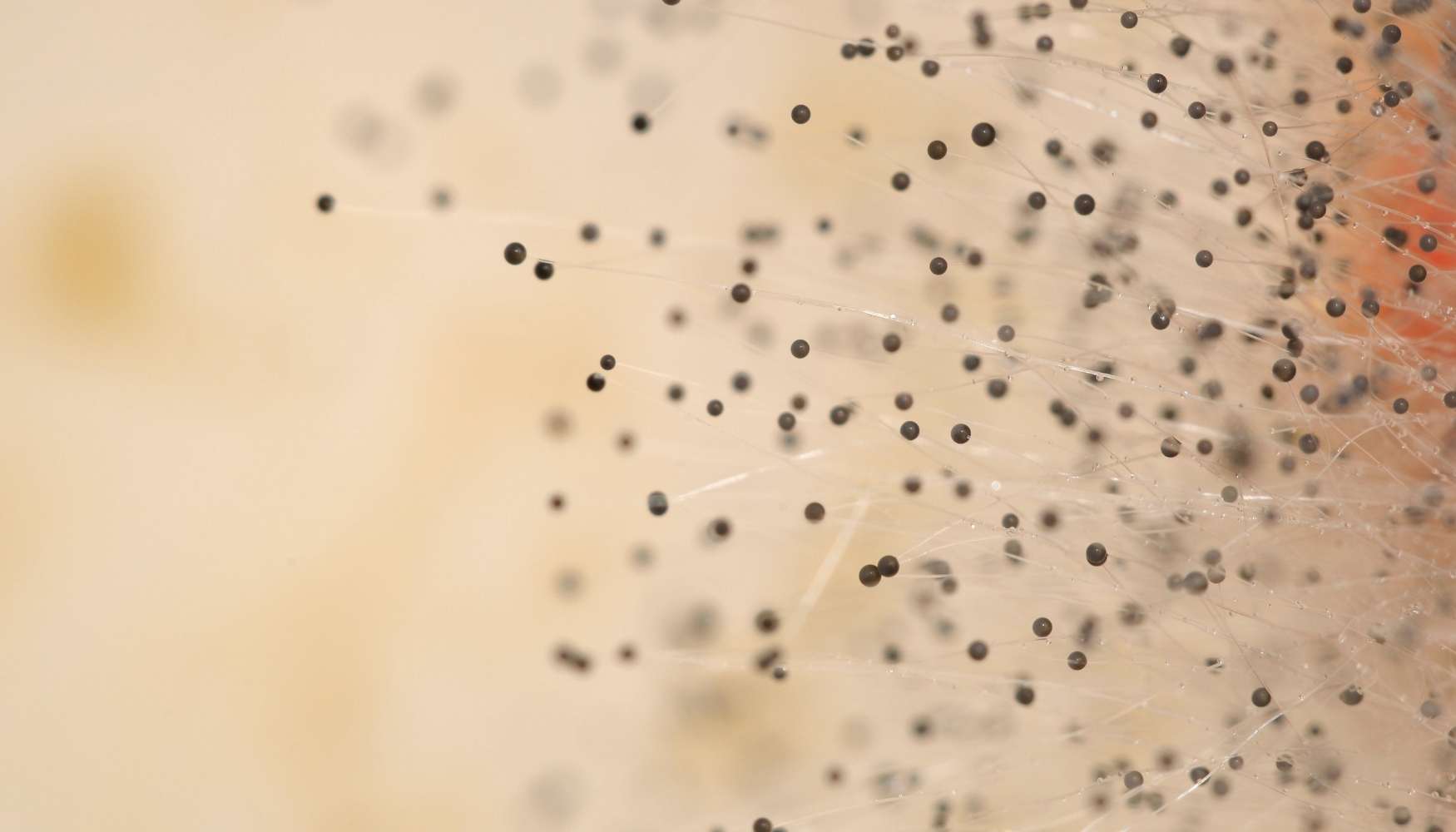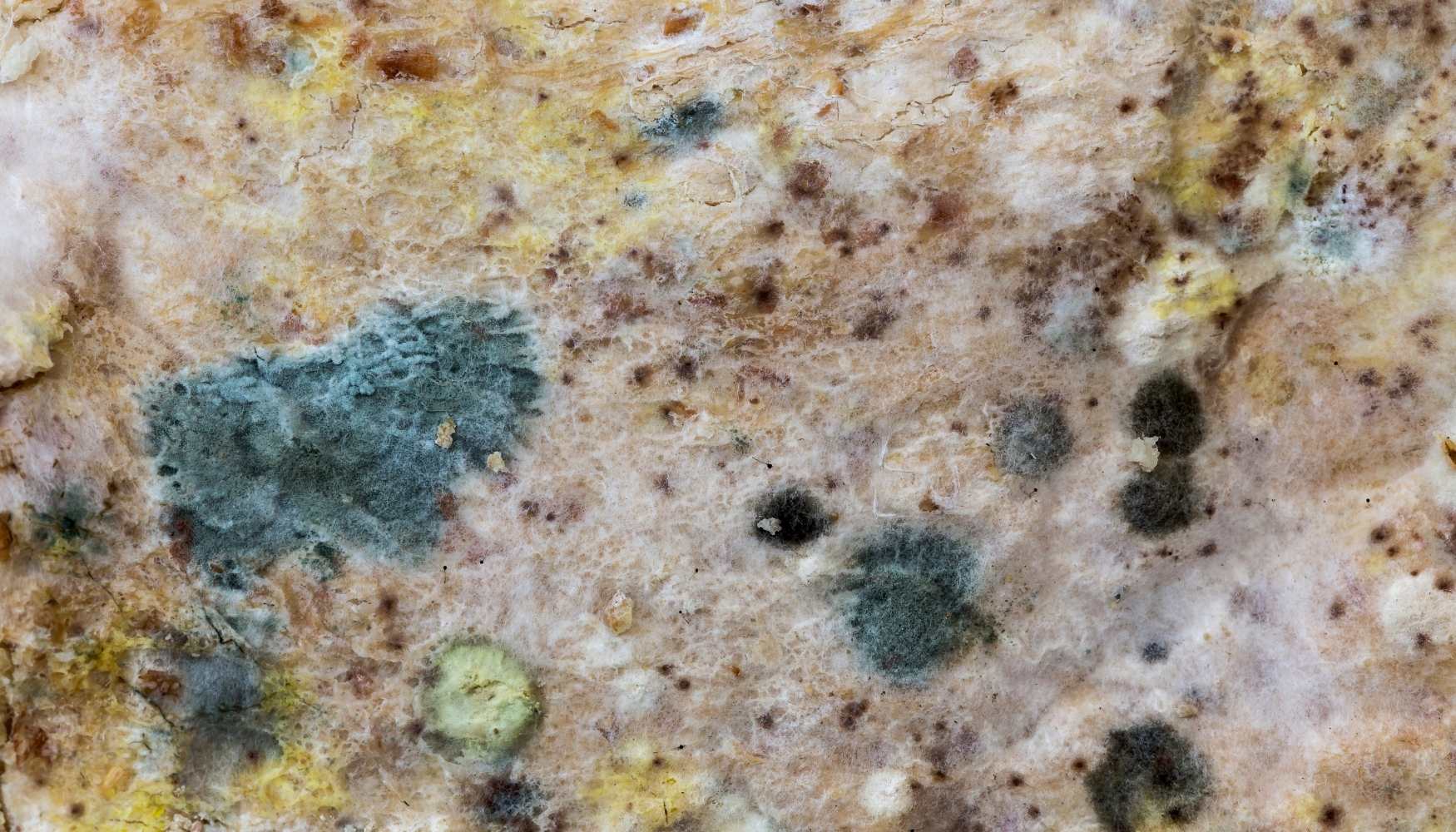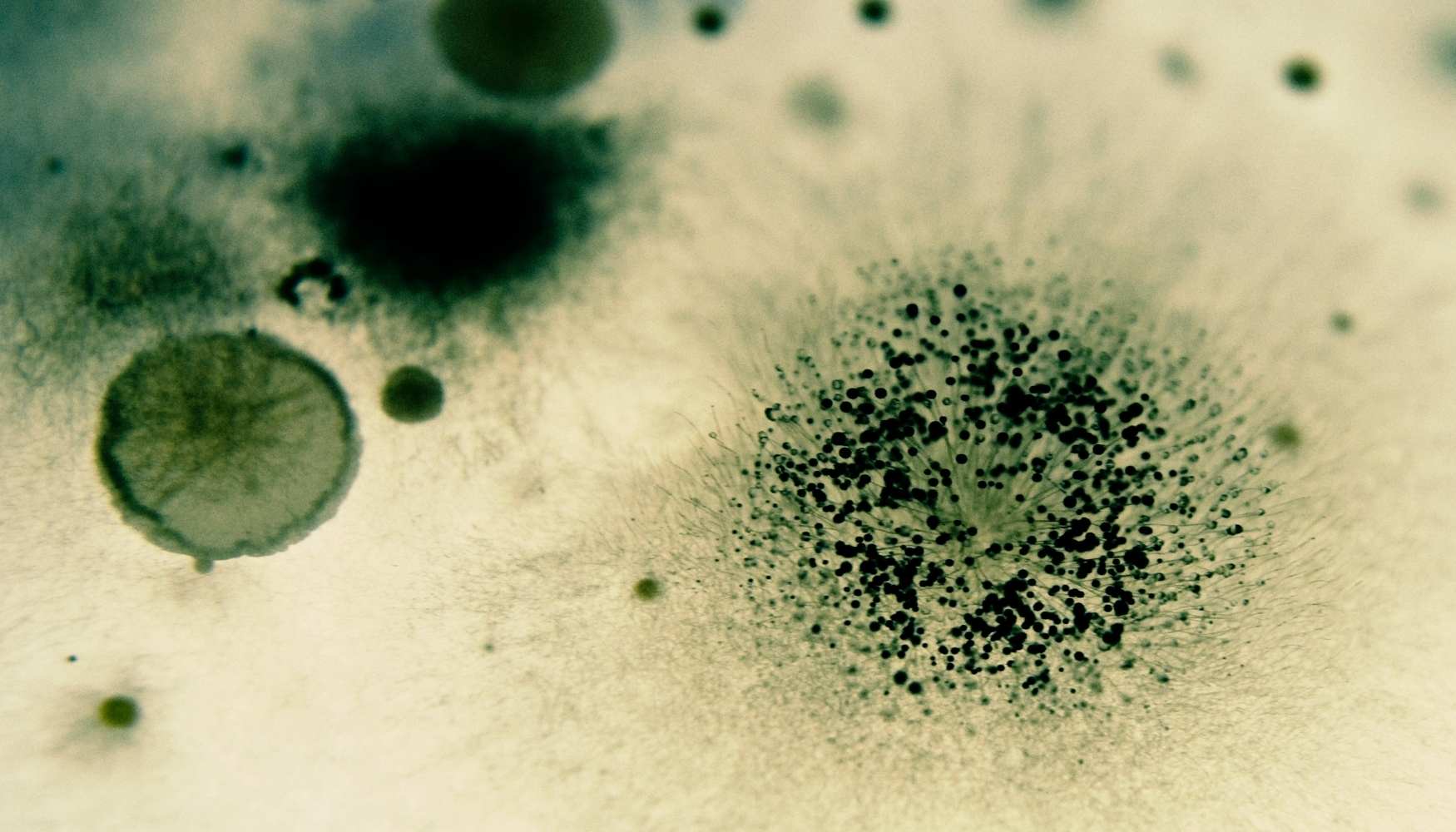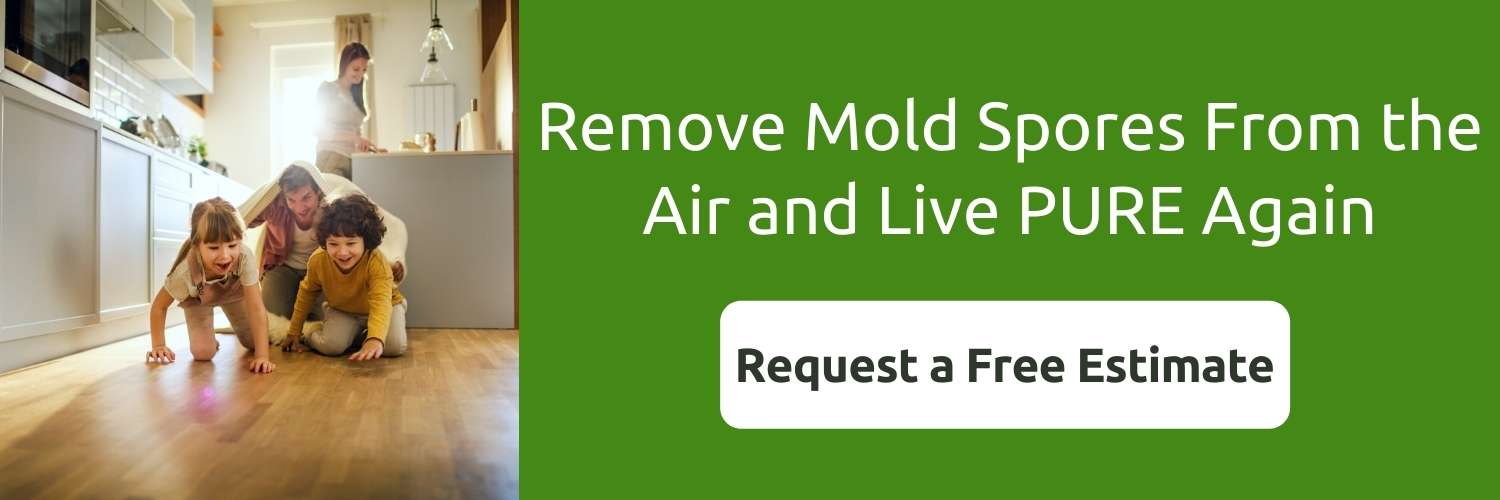Most people don’t think about mold until they see or smell it.
Yet you may be surprised to learn that mold spores are everywhere –– both indoors and outdoors.
Small amounts of mold spores are always floating in the air, they’re just so minute we can’t see them with the naked eye.
So how can you get rid of mold spores in the air and keep them from contaminating your home?
The key is to be thorough and tactical.
In this guide, you will learn some tips and tricks you can do at home to prevent and get rid of mold spores in the air, and when it’s time to call in the pros.
Table of Contents
- Mold Spores in the Air: What Are They and Where Do They Come From?
- How to Remove Mold Spores From the Air
- 2 Methods To Prevent Mold Spores From Settling
- 3 Ways to Prevent Mold Spores From Turning Into Mold
- Pure Environmental Can Help Get Rid of Mold Spores in the Air to Prevent Mold Growth From Occurring

Mold Spores in the Air: What Are They and Where Do They Come From?
Mold is a fungus that spreads by releasing spores.
Mold spores need specific conditions to grow into harmful mold: moisture and organic substrate (essentially, a material it can “eat”).
Thanks to many dark and rainy days, the concentration of mold spores found outdoors is higher in the fall months, while mold found indoors is highest in the winter.
Still, mold infestation is a problem more commonly found in homes.
The most likely areas for mold to grow in the home include:
- Basements
- Attics
- Bathrooms
- Kitchens
- Laundry rooms
- Mudrooms
Anywhere you might find…
- Moisture
- Leaks
- Dampness
- Groundwater seepage; or
- Humidity
…are likely places to find mold growing.
If you have mold growing in your home, it’s releasing spores in the air, which the World Health Organization (WHO) warns can create high enough concentrations to irritate your respiratory system, even if you don’t have mold-specific allergies.
How Long Do Mold Spores Stay in the Air?
A damp spot on a surface left unattended can cause mold to grow. How fast the mold grows will depend on the conditions. Mold can sometimes take a week or more to grow.
As mold grows, it continues to release spores.
It’s a vicious cycle, making it impossible to clean the air of mold spores completely.
Fortunately, mold spores at low concentrations usually don’t cause any harm unless you have a very sensitive allergy, although some molds are found to be at higher concentrations in certain geographical areas.
Can Mold Spores Be Removed From the Air Inside Your Home?
As unpleasant as it may be to imagine, mold spores can never be completely removed from the air inside your home.
There will always be a small amount of mold in the air, but there are ways to minimize the presence of mold including cleaning the air and preventing mold growth.
What Are the Benefits of Getting Rid of Airborne Mold Spores?
So if there will always be mold in the air, why bother trying to get rid of it?
There are a few key benefits to keeping the mold in your air to a minimum, including:
- Eliminating odors – Mold and mildew are the most common sources of that musty “basement” smell. The smell is created by the offgassing byproduct of the mold feeding on the substrate. Eliminating airborne mold spores will keep your home smelling fresh and clean.
- Creating a healthy environment – Remove mold spores and mildew to improve the overall air quality of your home and protect you from the dangerous toxins that can aggravate:
- Allergies
- Asthma; and
- Other respiratory illnesses
- Reducing the spread – Mold remediation assures you that it won’t spread to other areas in your house, preventing future damage.
- Saving renovation costs – Mold can cause significant damage to your home over time. Reducing the concentration of mold in your home as much as possible means you’re less likely to see mold growth in the event of future moisture.
- Increasing home value – Home inspections almost always include mold assessments. A mold-free home means you can ask for a higher market price without making concessions or losing potential buyers to the idea of facing massive mold removal expenses.
How to Remove Mold Spores From the Air
Every house and building has mold spores, and it’s impossible to completely get rid of every mold spore.
Mold spores are floating in the air, landing on surfaces –– they’re everywhere.
Still, the most effective way to drastically reduce the number of mold spores in the air is by exchanging the air and keeping clean air flowing.
Indoor air quality restoration professionals like Pure Environmental utilize two powerful tools to efficiently decontaminate air and surface particles of the mold spores that can infest your home.
Both tools use high-efficiency particulate air (HEPA) filters that can help clear up to 99.97% of mold spores and other particulates from the air.
HEPA technology was created by the U.S. Army Chemical Corps to capture fine pollutants as tiny as 0.3 microns in size.
The HEPA filter is popular because it removes…
- Bacteria
- Dust
- Chemicals
- Mold spores; and
- Allergens
… from the air.
You can be sure these machines using HEPA technology are thorough and effective, though the efficiency of the filter depends on the size and amount of particulates in your air.
Use a HEPA Filter Air Scrubber
Using an air scrubber with a HEPA filter can directly remove mold spores in the air.
An air scrubber is a powerful air and surface decontamination tool designed to safely remove:
- Odors
- Bacteria; and
- Other volatile organic compounds
… from indoor environments.
For optimal results, you need to have a strong enough filter that it produces sufficient air changes per hour. This allows you to scrub particles from the air.
How Does a HEPA Filter Air Scrubber Help to Get Rid of Mold Spores in the Air?
A HEPA filter air scrubber sends out negative ions to attach themselves to particles in the air and on surrounding surfaces.
The scrubber pulls both the airborne and surface particles into the machine and sends them through the filter using internal fans.
The negative ions make the pollutants heavier and easier to trap inside the dense materials of the HEPA filter.
Then the air scrubber circulates the purified air back into the room, leaving you with improved indoor air quality.
Install an Air Wash HEPA Filtration System
Air washers and air scrubbers both improve indoor air quality. However, some air washers may increase humidity in addition to removing pollutants.
Installing an air washer that introduces humidity can help those with respiratory issues by making the air more humid as well as capturing irritating particles and allergens from the air.
When installed by professionals like Pure Environmental, an Airwash HEPA filtration system can be tied into the return air duct of your existing HVAC system to …
- Divert
- Clean; and
- Introduce
…the air back into circulation.
Pure Environmental can also provide a free-standing unit to tailor any home air purification solution to suit you and your family’s needs.
Pure Environmental and Airwash HEPA filters can improve the quality of the air you breathe at home or in your office.
How Does an Air Wash HEPA Filtration System Help to Get Rid of Mold Spores in the Air?
An AirWash Filtrations System is a high-quality HEPA air purification scrubber that utilizes three stages of filtration:
- Pre-filters for debris
- HEPA filter technology; and
- Carbon filtration
These stages work to not only remove pollutants from the air but also the odors associated with those pollutants.
Dry, polluted air is pushed through a rotating water tray and enriched with humidity while mold spores and other pollutants are washed out in the water.
2 Methods to Prevent Mold Spores From Settling
Cleaning your air of floating mold spores is just a quick and temporary measure to keep them from settling.
As mold spores are naturally released into the air, the key is to keep them moving and circulating out of your home.
According to the Environmental Protection Agency (EPA), you can use these tips if your mold problem is relatively small in size (less than about ten square feet) or to prevent mold spores from settling.
Here are two methods that you can use without professional help to prevent mold spores from settling and making a home in your space.
#1: Increase Air Flow
Opening the windows and doors in your home often will discourage mold spores from settling.
Create a draft with open windows and leave them open for approximately 10 minutes. Then increase the temperature by turning up the thermostat. This will help remove moisture from the air and surfaces.
After three to four hours, the air can fill with moisture and mold spores again.
Open the windows for another 10 minutes and repeat the process of exchanging the indoor air with dry air from outside.
Continue this process every day to help limit airborne mold spores and keep them from settling.
#2: Ventilate Your Home
Incomplete and improper ventilation can cause mold to grow on:
- Walls
- Furniture; or
- Other surfaces
To keep mold spores at bay, ventilate your home for at least 30 minutes each day.
Create cross-ventilation by opening interior doors along with windows on opposing sides of the house.
Open any windows you may have in your kitchen to keep it ventilated while cooking or running your dishwasher. Turn on the exhaust fan on your oven and if you have a door to your kitchen, keep it closed with the windows open, moving any moisture out of the area.
Close your bathroom door during showers and baths. Leave a window ajar and turn on your exhaust fan to let moist air out.
Use any other …
- Fans
- Air conditioning units; or
- Appliances with exhaust fans
… to keep air ventilating throughout your home.

3 Ways to Prevent Mold Spores From Turning Into Mold
In addition to increasing the airflow and ventilation in your home to keep airborne mold spores from settling, consider these three ways to prevent harmful mold from growing.
#1: Keep Your Home Clean and Dry
You can keep mold at bay by being proactive. That means cleaning before or as soon as you see any beginning signs of mold growth.
Common early signs to look out for include:
- Musty or damp odors emanating from your floors or walls
- Mold illness includes symptoms like …
- Increased allergies
- Worsen asthma
- Watery eyes
- Skin irritation
- Runny or itchy nose
- Coughing; and
- Sneezing
… and can be an early sign of mold exposure.
- Water leaks or flooding can lead to …
- Bulging or warped walls
- Bubbles or cracked paint
- Peeling wallpaper
- Stained or discolored carpet
… which can indicate mold growing behind these areas where the water was.
So be sure to keep your home clean and dry to eliminate the opportunity for mold to grow.
#2: Regulate Humidity Levels
A humid environment is a breeding ground for mold because it needs moisture to grow and thrive.
So keeping humidity levels regulated in your home can help keep the airborne mold spores from attaching to surfaces like your walls or floors.
Condensation on your doors or windows is a sure sign of moisture and high humidity in your home which can lead to mold.
To regulate humidity levels in your home, consider investing in a dehumidifier.
With a good dehumidifier, you can eliminate any moisture by setting the desired humidity level in your home.
Set your dehumidifier to 50% humidity or less and place it in problem areas or rooms with visible mold to reduce or prevent mold growth.
#3: Use an Air Purifier
Air purifiers pull airborne mold spores through the machine, trapping them in the HEPA filter, and sending clean air back out.
You don’t need to hire a professional to use an air purifier.
You can find a quality air purifier at most home improvement or retail stores, but be sure to follow the manufacturer’s instructions for effective results.
Most air purifiers are designed to purify the air inside a single room and have a limited reach so the more you place throughout your home, the better.
Unlike air scrubbers or air washers, air purifiers can only clean the air and do not remove particles that may be attached to surfaces or add humidity to the air.
If you have a larger space or need a more comprehensive solution, hiring a team of experts like those at Pure Environmental can offer the best technology and methods available to quickly and safely remove mold contamination from your home.

Pure Environmental Can Help Get Rid of Mold Spores in the Air to Prevent Mold Growth From Occurring
One of the few drawbacks of living in the beautiful Pacific Northwest is the excess moisture, which if left untreated can lead to mildew and mold growth.
Whether you’re facing the clean-up after a flood or ongoing maintenance in your home, Pure Environmental can help with mold prevention and removal.
No two situations are the same and our experts have seen and removed it all.
Our powerful air and surface decontamination air scrubbers utilize cutting-edge technology designed to safely …
- Oxidize
- Neutralize; and
- Improve
… the air quality in any indoor environment.
We also provide both residential and commercial installation services of a three-level AirWash HEPA air filtration system that effectively eradicates 99.97% of:
- Mold spores
- Allergens
- Odor molecules
- Viruses (including COVID-19); and
- Other pathogens
You can choose to …
- Adapt your current HVAC system; or
- Implement a free-standing air purification system
… to cut through the toughest of mold issues.
At Pure Environmental, we’ve got you covered.
Contact us today for an estimate.
Recent posts
- Should You Stay or Should You Go? Know When To Walk Away From a House With Mold
- How To Get Rid of Weed Smell: Top Tips To Help Cannabis Users and Growers Keep Their Homes Smelling Fresh and Clean
- HVAC System Longevity and Understanding When It’s Time To Replace Yours
- How To Remove Mold From Basement Walls: Guidance for Safe Mold Removal Practices
- Uncovering the Truth About Black Mold: A Guide, FAQs, and More
